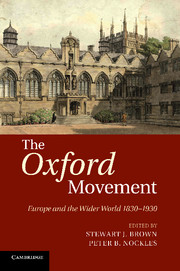66 results
25 The Relationship between Judgment and Cognitive Performance in a Mixed-Clinical Older Adult Veteran Sample
-
- Journal:
- Journal of the International Neuropsychological Society / Volume 29 / Issue s1 / November 2023
- Published online by Cambridge University Press:
- 21 December 2023, pp. 707-708
-
- Article
-
- You have access
- Export citation
Associations between psychological therapy outcomes for depression and incidence of dementia
-
- Journal:
- Psychological Medicine / Volume 53 / Issue 11 / August 2023
- Published online by Cambridge University Press:
- 15 September 2022, pp. 4869-4879
-
- Article
-
- You have access
- Open access
- HTML
- Export citation
Scottish Presbyterian worship. Proposals for organic change, 1843 to the present day. By Bryan D. Spinks. Pp. xx + 299 incl. frontispiece and 21 ills. Edinburgh: Saint Andrew Press, 2020. £25. 978 1 8008 3000 4
-
- Journal:
- The Journal of Ecclesiastical History / Volume 73 / Issue 3 / July 2022
- Published online by Cambridge University Press:
- 15 July 2022, pp. 677-678
- Print publication:
- July 2022
-
- Article
- Export citation
Introduction
-
- Journal:
- Studies in Church History / Volume 54 / June 2018
- Published online by Cambridge University Press:
- 14 May 2018, pp. 1-15
- Print publication:
- June 2018
-
- Article
- Export citation
Providential Empire? The Established Church of England and the Nineteenth-Century British Empire in India
-
- Journal:
- Studies in Church History / Volume 54 / June 2018
- Published online by Cambridge University Press:
- 14 May 2018, pp. 225-259
- Print publication:
- June 2018
-
- Article
- Export citation
MORAL CULTURE AND HISTORICAL PROGRESS IN THE SCOTTISH ENLIGHTENMENT
-
- Journal:
- Modern Intellectual History / Volume 16 / Issue 3 / November 2019
- Published online by Cambridge University Press:
- 30 January 2018, pp. 993-1005
-
- Article
- Export citation
Radio Emission from Starspots on RSCVn Binary HR1099
-
- Journal:
- Publications of the Astronomical Society of Australia / Volume 6 / Issue 3 / 1986
- Published online by Cambridge University Press:
- 25 April 2016, pp. 316-319
-
- Article
- Export citation
Assessing risk factors of sporadic Campylobacter infection: a case-control study in Arizona
-
- Journal:
- Epidemiology & Infection / Volume 144 / Issue 4 / March 2016
- Published online by Cambridge University Press:
- 30 September 2015, pp. 829-839
-
- Article
-
- You have access
- HTML
- Export citation
W. T. Stead and the Civic Church, 1886-1895: The Vision Behind ‘If Christ Came to Chicago!’
-
- Journal:
- The Journal of Ecclesiastical History / Volume 66 / Issue 2 / April 2015
- Published online by Cambridge University Press:
- 17 April 2015, pp. 320-339
- Print publication:
- April 2015
-
- Article
- Export citation
Enlightened Evangelicalism: The Life and Thought of John Erskine. By Jonathan M. Yeager. New York: Oxford University Press, 2011. xii + 321 pp. $74.00 cloth.
-
- Journal:
- Church History / Volume 81 / Issue 3 / September 2012
- Published online by Cambridge University Press:
- 02 August 2012, pp. 706-708
- Print publication:
- September 2012
-
- Article
- Export citation
Contributors
-
-
- Book:
- Ethnic Diversity and Economic Instability in Africa
- Published online:
- 05 August 2012
- Print publication:
- 19 July 2012, pp x-xii
-
- Chapter
- Export citation
Notes on contributors
-
-
- Book:
- The Oxford Movement
- Published online:
- 05 July 2012
- Print publication:
- 28 June 2012, pp ix-xi
-
- Chapter
- Export citation
Abbreviations
-
- Book:
- The Oxford Movement
- Published online:
- 05 July 2012
- Print publication:
- 28 June 2012, pp xii-xii
-
- Chapter
- Export citation
Introduction
-
-
- Book:
- The Oxford Movement
- Published online:
- 05 July 2012
- Print publication:
- 28 June 2012, pp 1-8
-
- Chapter
- Export citation
Dedication
-
- Book:
- The Oxford Movement
- Published online:
- 05 July 2012
- Print publication:
- 28 June 2012, pp v-vi
-
- Chapter
- Export citation
The Oxford Movement - Title page
-
-
- Book:
- The Oxford Movement
- Published online:
- 05 July 2012
- Print publication:
- 28 June 2012, pp iii-iii
-
- Chapter
- Export citation
Copyright page
-
- Book:
- The Oxford Movement
- Published online:
- 05 July 2012
- Print publication:
- 28 June 2012, pp iv-iv
-
- Chapter
- Export citation
Part I - Beyond England:
-
- Book:
- The Oxford Movement
- Published online:
- 05 July 2012
- Print publication:
- 28 June 2012, pp 35-150
-
- Chapter
- Export citation
Part II - The Oxford Movement and continental Europe
-
- Book:
- The Oxford Movement
- Published online:
- 05 July 2012
- Print publication:
- 28 June 2012, pp 151-265
-
- Chapter
- Export citation

The Oxford Movement
- Europe and the Wider World 1830–1930
-
- Published online:
- 05 July 2012
- Print publication:
- 28 June 2012



